

After the conclusion of the 8th China-South Asia Exposition and the 28th China Kunming Import and Export Fair in Kunming, southwest China’s Yunnan Province, Chen Tao promptly returned to her village in the province’s Pu’er city.
“Within just three hours of opening our exhibition booth at the expo, we sold 11 scarves and eight aprons. Within three days of the expo’s opening, we received orders worth 160,000 yuan (approximately $22,170),” said Chen, who serves as the first secretary of Banmu village in Ximeng Wa Autonomous County, Pu’er city.
Even before the delegation returned to the village, local villagers had already begun working to meet the orders.
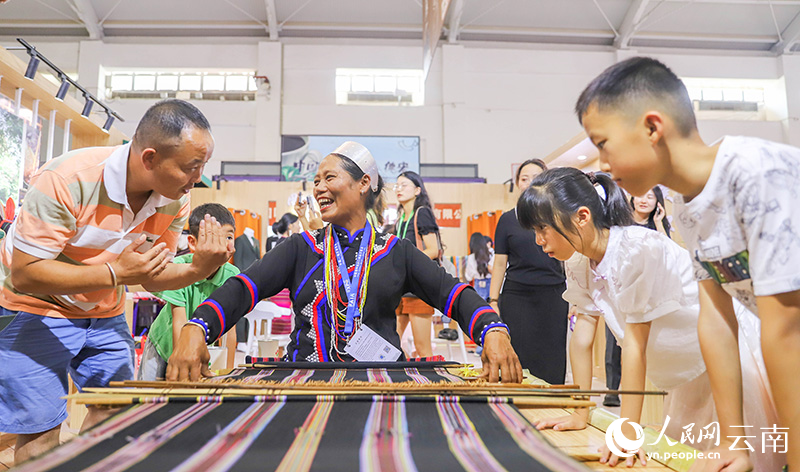
A villager from Banmu village, Ximeng Wa Autonomous County, Pu’er city, displays the technique of Wa brocade weaving, during the 8th China-South Asia Exposition and the 28th China Kunming Import and Export Fair in Kunming, southwest China’s Yunnan Province. (People’s Daily Online/Hu Zunhui)
“During last year’s expo, our exhibition booth covered only 10 square meters, and this year, that area reached 72 square meters,” said Chen.
Recognized as a national intangible cultural heritage in May 2021, Wa brocade weaving is renowned for its intricate patterns. It is also an important source of income for the Wa ethnic group.
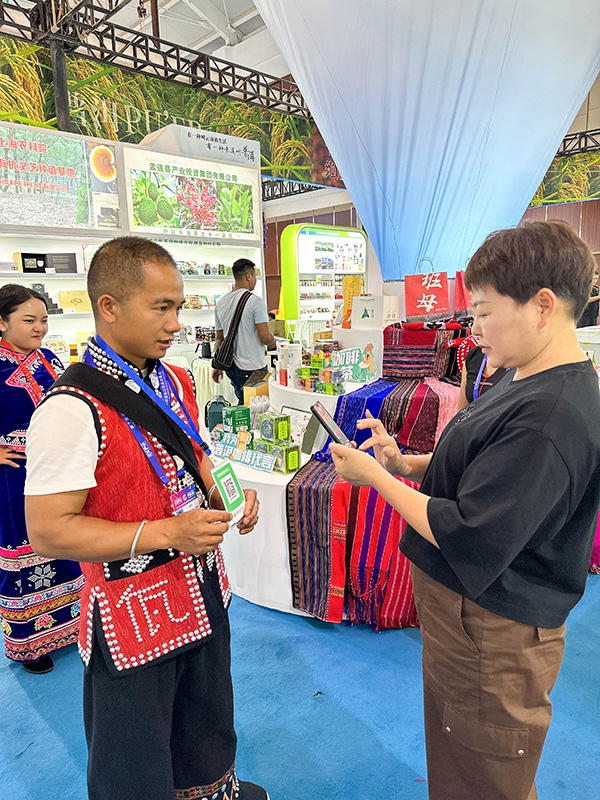
Yan Hua, a man of the Wa ethnic group, sells Wa brocade products during the 7th China-South Asia Expo in Kunming, southwest China’s Yunnan Province, in 2023. (Photo courtesy of the interviewee)
According to Li Keli, deputy director of the Bureau of Agriculture, Rural Affairs, Science, and Technology in Ximeng Wa Autonomous County, women traditionally sit on the ground while weaving Wa brocade products. Crafted with skill and unwavering patience, it takes approximately 10 to 15 days to complete a piece of exquisite Wa brocade product.
In recent years, the county has leveraged Wa brocade to increase income and has established a comprehensive industrial chain centered around this traditional craft. Significant strides have been made in this endeavor.
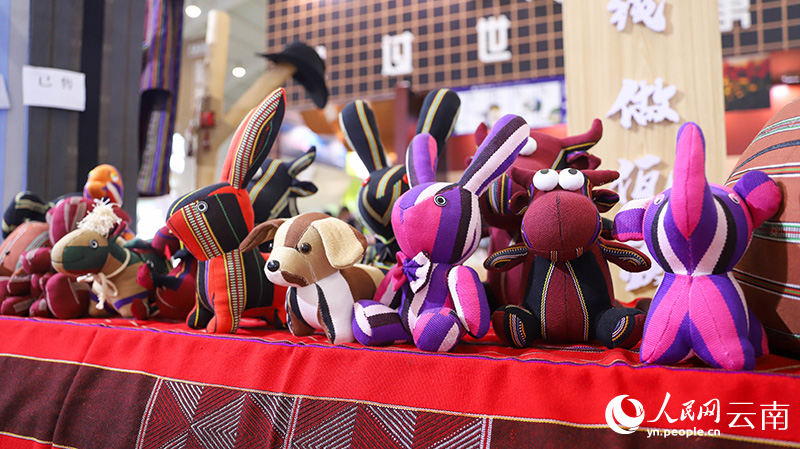
Photo shows dolls crafted using yarn made from used coffee grounds. (People’s Daily Online/Hu Zunhui)
“When the work team visited the village in June 2023, we were impressed by the stunning items crafted from Wa brocade. We realized that these creations had the potential to be turned into merchandise, opening up new avenues for economic prosperity,” Chen recalled.
Chen led a delegation comprising village cadres, officials, and artisans of Wa brocade weaving to participate in the 7th China-South Asia Expo in Kunming. The exquisite Wa brocade works garnered significant attention during the event.
“We only brought a limited selection of finished brocade products to the expo, and they received a positive response,” said Chen. She further revealed that a villager named Yan Hua managed to sell brocade products worth 16,000 yuan in just five days. “This amount surpassed the average per capita net income of the village in 2022,” Chen added.
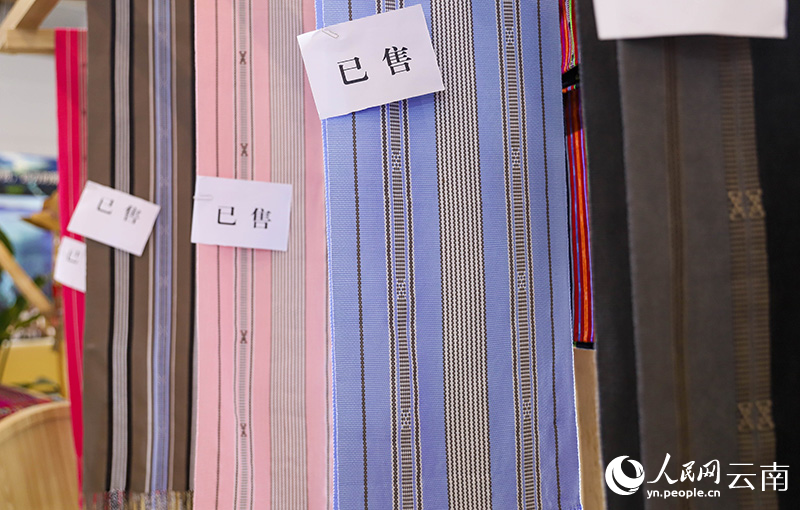
Photo shows scarves crafted using yarn made from used coffee grounds. (People’s Daily Online/Hu Zunhui)
Upon returning from the expo, the work team spearheaded the establishment of the county’s first Wa brocade cooperative and registered a trademark for it.
After conducting surveys and market research, the work team discovered that developing new products tailored to the preferences of urban consumers was a key factor in promoting the popularity of traditional Wa brocade.
The team reached out to a tie manufacturer in east China’s Zhejiang Province for a partnership in the design and production of ties. Simultaneously, it also established contact with a domestic clothing manufacturer to build a partnership in the design and production of women’s business attire.
In March 2024, Chen participated in the Yarn Expo in Shanghai with the aim of addressing yarn-related challenges.
“While attending the expo, I came across two manufacturers that were able to produce yarn from used coffee grounds. This inspired me to explore the possibility of using coffee grounds to create yarn for Wa brocade,” Chen explained.
Given that the coffee cultivation area in Yunnan accounts for more than 98 percent of the total nationwide, it can serve as a reliable source of raw material for yarn production.
Upon learning about the demand for used coffee grounds, the Yunnan Provincial Department of Agriculture and Rural Affairs quickly matched two yarn production companies with coffee enterprises in Yunnan that could supply the needed coffee grounds, solving the raw material issue for coffee yarn production.
In mid-June, the first batch of yarn made from coffee grounds produced in Yunnan arrived in Ximeng Wa Autonomous County, marking the first use of coffee yarn in the crafting of Wa brocade.
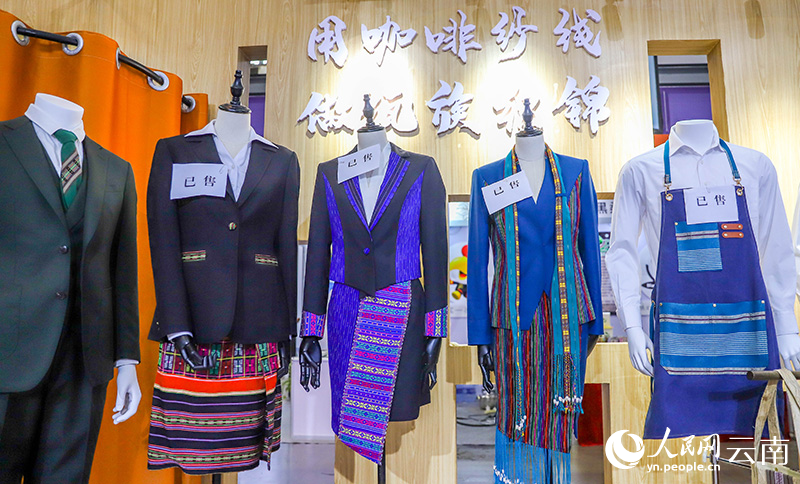
Photo shows women’s formal attire and aprons crafted using yarn made from used coffee grounds. (People’s Daily Online/Hu Zunhui)
“Our exhibition booth at this year’s expo showcased the production process of Wa brocade, as well as yarn made from coffee grounds, brocade products crafted using yarn made from coffee grounds, and other handicrafts,” said Chen.
The booth, themed “Wearing Coffee,” captured the interest of numerous exhibitors and tourists.
“Transforming coffee grounds into yarn not only effectively reduces coffee waste pollution but also allows for resource reuse. This coffee yarn possesses remarkable qualities such as moisture absorption, moisture-wicking, antibacterial property, breathability, warmth, and is even lightweight. It has extensive applications in clothing, shoes, bedding, pillows, and more,” Chen said.
点击右上角![]() 微信好友
微信好友
 朋友圈
朋友圈

请使用浏览器分享功能进行分享
